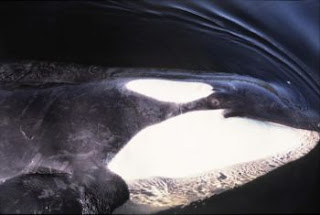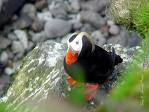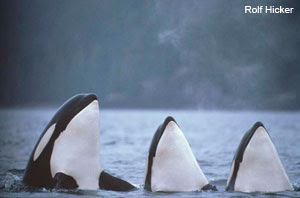As I blogged last week, I have been touring around the North Island coordinating video interviews. One subject came up quite often in Port McNeill and Alert Bay, and interestingly enough, there was an article in last Friday's Globe and Mail about it. "It" would be the low pink salmon returns, particularly to the Glendale River in Knight Inlet and the effect that this is having on the grizzly bears up there. I've included the article here, and while this wouldn't be the first time that low salmon returns have had an effect on grizzly bears around here (I'm thinking of the fallout from the chinook collapse in the
Wannock around 1999), it is still unpleasant to think about what things will be like next spring.
Declining salmon runs blamed for wilderness tourism slump
MARK HUME
From Friday's Globe and Mail
September 19, 2008 at 4:31 AM EDT
VANCOUVER — Few people in British Columbia know how to find killer whales better than Bill MacKay, who tracks them in a high-speed, super-quiet boat from Port McNeill, on northern Vancouver Island.
But Mr. MacKay, who with his wife, Donna, runs MacKay Whale Watching, has had an increasingly difficult time finding large numbers of killer whales to show his customers this year.
All along the B.C. Coast, wilderness tourism operators who run bear-viewing, whale-watching and sport-fishing resorts are reporting tough times because of declining salmon runs.
But the biggest impact may be occurring in the Broughton Archipelago, where Mr. MacKay operates, and where pink salmon runs have all but vanished, sending a shock wave through the region's ecosystem.
"Some of the northern pods are just not here," Mr. MacKay said yesterday. "And we've had three occasions [this summer] when we did not see any orcas at all. That's pretty weird."
He said northern killer whales visit the area during the summer months, collecting in big social gatherings where breeding takes place.
"When they get together like that it's called Super Pod Day, and we will see over 100 dorsal fins out there at a time," Mr. MacKay said. "That didn't happen this year, for the first time since we've been collecting data, which is almost 30 years."
Mr. MacKay said it's not coincidental that the whales have vanished along with the salmon.
"It's pretty simple. ...What do you think these orcas eat?" he said.
Surveys by the Department of Fisheries and Oceans indicate pink salmon stocks have fallen to extremely low levels in the Broughton Archipelago. In Glendale Creek, a key indicator stream, there have been only 19,000 spawners counted this year, compared with 264,000 last year.
Pink salmon, which usually spawn in prodigious numbers, are a keystone species on the West Coast. Chinook salmon, the mainstay of the orca diet, feed on young pinks, while grizzly and black bears depend on spawning adult pink salmon to bulk up for hibernation.
Howard Pattinson, owner of Tide Rip Tours, a grizzly-bear viewing business based in Telegraph Cove, said the pink collapse has forced bears to rely on late berry crops and sedge grasses for nutrition.
"We're used to seeing bears eat 15 to 20 fish an hour. Now once a day we might see a bear catch one fish," Mr. Pattinson said. "We are seeing big male bears killing [yearling] cubs and eating them. ...It's pretty shocking for the tourists when they see raw nature like that."
Mr. Pattinson said he's worried about the future of his business.
"The bears are now eating berries and sedges. It's enough to get through the winter, but not enough for pregnant females. They'll either reabsorb their embryos or abort this winter. ...Next spring, I don't think there'll be any cubs," he said.
Brian Gunn, president of the Wilderness Tourism Association, said the collapse of salmon stocks is threatening the survival of ecotourism businesses.
"The bear-viewing businesses, the whale-watching operations, they built up a lot of equity showing people these wild animals. Now the fish aren't there and they are seeing their equity drain away. ...If the salmon go, so does the wildlife, and so does the business."
Mr. Gunn blamed the fish-farming business, saying a heavy concentration of net pens in the Broughton Archipelago has created sea-lice epidemics which kill young salmon.

























